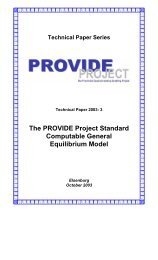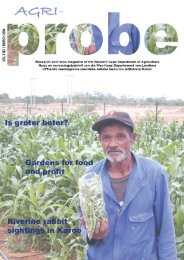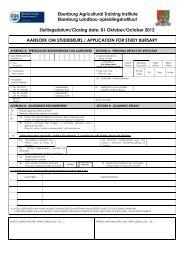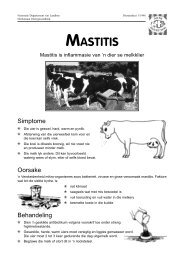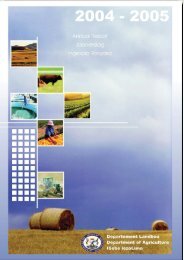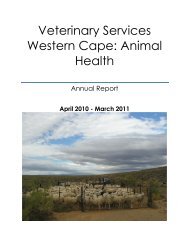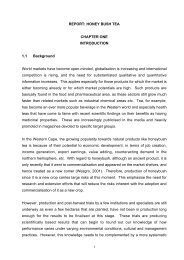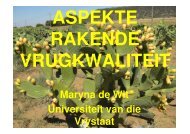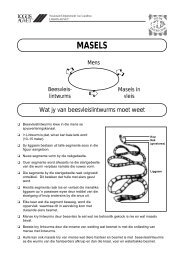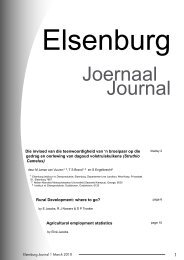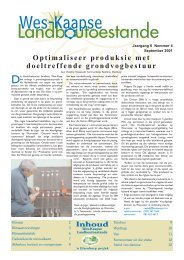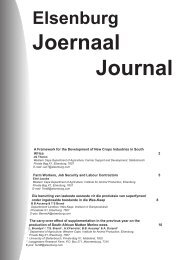Download AgriProbe - Department of Agriculture: Western Cape
Download AgriProbe - Department of Agriculture: Western Cape
Download AgriProbe - Department of Agriculture: Western Cape
You also want an ePaper? Increase the reach of your titles
YUMPU automatically turns print PDFs into web optimized ePapers that Google loves.
For the extensive small grain cropping industry in the<br />
<strong>Western</strong> and Southern <strong>Cape</strong> to become viable, the<br />
natural vegetation (including all the trees and the<br />
shrubs) had to be removed. The trees occurring naturally<br />
in the <strong>Western</strong> <strong>Cape</strong> are all slow growers. This resulted<br />
in foreign trees (like Eucalyptus) being planted to provide<br />
shade in the few places it was desired. However, plantings<br />
were limited, because <strong>of</strong> the shade the tall Eucalypts<br />
casted on adjacent crops, and also because <strong>of</strong> a “dead<br />
zone” in the root area <strong>of</strong> these plants. Trees and other<br />
structures for the provision <strong>of</strong> shade to extensive livestock<br />
is therefore largely absent in the cropping areas <strong>of</strong> the<br />
<strong>Western</strong> and Southern <strong>Cape</strong>.<br />
Against this background we provide results <strong>of</strong> a study<br />
on the provision <strong>of</strong> shade to sheep in the Swartland cropping<br />
area.<br />
The study was conducted at the Langgewens Research<br />
Station <strong>of</strong> the <strong>Western</strong> <strong>Cape</strong> <strong>Department</strong> <strong>of</strong><br />
<strong>Agriculture</strong> between Malmesbury and Moorreesburg. The<br />
climate at the experimental site is Mediterranean, and<br />
78% <strong>of</strong> the total long-term annual precipitation <strong>of</strong> 395 mm<br />
is recorded during winter (normally lasting from April to<br />
September). The Swartland area is characterised by dry,<br />
hot and windy summers. Long term weather data indicate<br />
that average monthly temperatures exceeding 30°C are<br />
common during the period from December to February.<br />
Merino ewes annually lambed in eight paddocks <strong>of</strong><br />
approximately 1ha each from 1996 to 1998. Data <strong>of</strong> 497<br />
ewes and their <strong>of</strong>fspring were recorded. The ewes were<br />
adapted to the paddocks for two weeks prior to the com-<br />
Provide shade<br />
for reproducing<br />
ewes<br />
7<br />
mencement <strong>of</strong> lambing usually by about 20 February each<br />
year. They remained in the paddocks throughout lambing,<br />
and for an extra 14-21 days prior to lambmarking, usually<br />
towards the end <strong>of</strong> April. Shade structures were erected<br />
in four <strong>of</strong> the paddocks, while the other four paddocks<br />
served as controls. Shade structures consisted <strong>of</strong> corrugated<br />
iron ro<strong>of</strong>s, mounted on the top <strong>of</strong> six wooden posts.<br />
The ro<strong>of</strong> area <strong>of</strong> the structures was 3x4 m, and the ro<strong>of</strong>s<br />
were elevated to 1.8 meter above ground level. Water meters<br />
were installed in the water supply line to all paddocks.<br />
This allowed the measurement <strong>of</strong> water consumption on a<br />
per paddock basis. Concentrate and roughage consumption<br />
were recorded similarly. This allowed the calculation<br />
<strong>of</strong> water and feed intake on a per ewe basis. Birth weight,<br />
survival to weaning and weaning weight were recorded for<br />
individual lambs.<br />
Average feed intake on a paddock basis was not affected<br />
by shading treatment (1.505kg/ewe/day in control<br />
paddocks vs. 1.504kg/ewe/day in paddocks with shade<br />
structures). The lack <strong>of</strong> response in feed intake between<br />
the shaded and control groups could possibly be ascribed<br />
to cooler environmental conditions at night when animals<br />
were able to maintain a normal feed intake. Ewes kept in<br />
control paddocks without shade drank 26% more water<br />
during the experimental period than sheep in paddocks<br />
with shade (3.878 vs. 3.076l/ewe/day respectively).<br />
Casual observations <strong>of</strong> the behaviour <strong>of</strong> sheep with and<br />
without access to shade indicated that most ewes stayed<br />
in the shade with their lambs from about 10:00 until late afternoon.<br />
They moved out <strong>of</strong> the shade for varying intervals<br />
AgriPROBE Photo: September Schalk 2007 Cloete



